|
|
| (145 intermediate revisions by 4 users not shown) |
| Line 1: |
Line 1: |
| − | ==ALGADEC - Detection of toxic algae with a semi-automated nucleic acid biosensor== | + | <div style="float:right; margin-left:10px; margin-top:5px">[[File:Compendiumcoastandsea.jpg|160px|right|link=Compendium for Coast and Sea - creating a marine science-policy interface]]</div> |
| − | [[Image:ALGADEC_1.jpg|thumb|left|'''Figure 1''' Bloom of ''Noctiluca scintillas'' in October 2002, Leigh, New Zealand.]] | + | '''Compendium for Coast and Sea - creating a marine science-policy interface''' |
| − | | + | <p style="margin-top:-15px"><br/></p> |
| − | Microalgae are the major producers of [[Biomass|biomass]] and organic compounds in the aquatic environment. Among the marine microalgae there are 97 toxic species (mainly dinoflagellates) known to have the potential to form "[[Harmful_algal_blooms|Harmful Algal Blooms]]", the so called HABs (Fig. 1).
| + | The Compendium for Coast and Sea is an integrated knowledge document about the socio-economic, environmental and institutional aspects of the coast and sea in Flanders and Belgium. As such, it constitutes a one-stop shop for data and information from the Flemish and Belgian marine and maritime research community and experts. The Compendium for Coast and Sea is an initiative of the Flanders Marine Institute (VLIZ) and was developed in close collaboration with experts from the research community, government, industry and civil society organisations. The first version of the Compendium was launched in 2013, a second edition was presented in 2015. |
| − | In recent decades, the public health and economic impacts of toxic algae species appear to have increased in frequency, intensity and geographic distribution (Zingone and Enevoldsen, 2000<ref name="Z&E">Zingone, A. & Enevoldsen, H.O. (2000). The diversity of harmful algal blooms: a challenge for science and management. Ocean & coastal management, 43, 725-748.</ref>, Daranas et al., 2001<ref name="D">Daranas A. H., Norte M. and Fernandez, J. J. (2001). Toxic marine microalgae, Toxicon, 39, 1101-1132.</ref>, Hallegraeff, 2003<ref name="H">Hallegraeff G. M. (2003). Harmful algal blooms: a global overview. In G.M. Hallegraeff, D.M. Anderson & A.D. Cembella (Eds.), Manual on Harmful Marine Microalgae (pp. 25-49). United Nations Educational, Scientific and Cultural Organization.</ref>, Moestrup, 2004.<ref name="M"> Moestrup, O. (2004). IOC Taxonomic Reference list of Toxic Algae. In O. Moestrup (Ed.), IOC taxonomic reference list of toxic algae. Intergovernmental Oceanographic Commission of the UNESCO.</ref>). In order to minimise the damage to human health or living resources, such as shellfish and fish, as well as economic losses to fishermen, aquaculture and the tourist industry, efficient [[State of the Art Overview on Field Observation Techniques (Theme 9)|monitoring methods]] are required for monitoring potentially toxic algal species (identification and quantification) (Andersen et al., 2003.<ref name="A"> Andersen P., Enevoldsen H. and Anderson, D.M. (2003). Harmful algal monitoring programme and action plan design. In G.M. Hallegraeff, D.M. Anderson & A.D. Cembella (Eds.), Manual on Harmful Marine Microalgae (pp. 627-647). United Nations Educational, Scientific and Cultural Organization.</ref>).
| + | </div> |
| − | In order to detect toxic algae in the field, a portable semi-automated nucleic acid biosensor was developed in the ALGADEC project www.algadec.net. This device enables the electrochemical detection of microalgae from water samples in less than two hours, without the need of expensive equipment.
| |
Compendium for Coast and Sea - creating a marine science-policy interface
The Compendium for Coast and Sea is an integrated knowledge document about the socio-economic, environmental and institutional aspects of the coast and sea in Flanders and Belgium. As such, it constitutes a one-stop shop for data and information from the Flemish and Belgian marine and maritime research community and experts. The Compendium for Coast and Sea is an initiative of the Flanders Marine Institute (VLIZ) and was developed in close collaboration with experts from the research community, government, industry and civil society organisations. The first version of the Compendium was launched in 2013, a second edition was presented in 2015.
